U.S. Electricity Grid & Markets
Green power markets are just a part of the larger energy market in the United States. In order to understand the role of renewable energy in the electricity market, it is important to know how the U.S. electricity grid and market are organized.
The electricity grid is a complex machine in which electricity is generated at centralized power plants and decentralized units and is transported through a system of substations, transformers and transmission lines that deliver the product to its end-user, the consumer. Since large amounts of energy cannot be stored, electricity must be produced as it is used.
According to the U.S. Energy Information Administration Exit, the U.S. power grid is made up of over 7,300 power plants, nearly 160,000 miles of high-voltage power lines, and millions of miles of low-voltage power lines and distribution transformers, connecting 145 million customers throughout the country (EIA, 2016).
Electricity in the United States is generated using a variety of resources and technologies. The majority of electricity is produced using conventional sources such as, natural gas, oil, coal and nuclear.
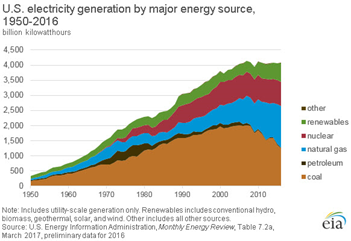
More recently, however, some of the fastest growing sources of electricity are sourced from renewable resources (e.g. wind, solar, etc).
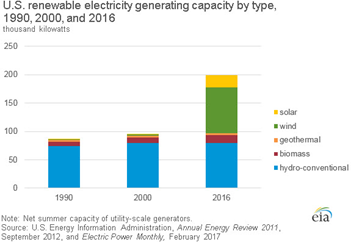
Larger electricity networks are created through the interconnection of local grids, which are linked for commercial and reliability purposes. At the highest level, the network covering the lower 48 states is comprised of three major interconnections Exit, functioning predominantly independently of one another with limited exchanges of power between them.
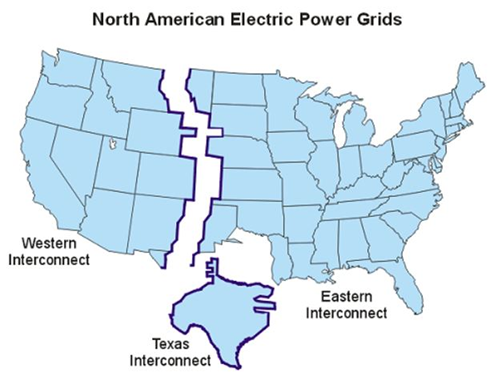
- The Eastern Interconnection comprises the area from the Great Plains states (excluding most of Texas) eastward to the Atlantic coast.
- The Western Interconnection comprises the area west of the Rocky Mountains and the Great Plains to the Pacific coast.
- The Electric Reliability Council of Texas (ERCOT) covers most of the state of Texas.
The vast network structure of the interconnections improves economics by allowing generators to be optimally sited and helps maintain the stability and reliability of the grid by delivering multiple pathways for power to flow. The redundant design of the grid helps prevent service interruptions to retail customers due to transmission line or power plant failures. Regional balancing authorities serve to manage grid operations to ensure that electricity supply constantly matches power demand in a balance that maintains the reliable service of the electric grid system.
Wholesale Electricity Markets
U.S. electricity markets have both wholesale and retail components. Wholesale markets involve the sales of electricity among electric utilities and electricity traders before it is eventually sold to consumers. Retail markets involve the sales of electricity to consumers. Both wholesale and retail markets can be traditionally regulated or competitive markets.
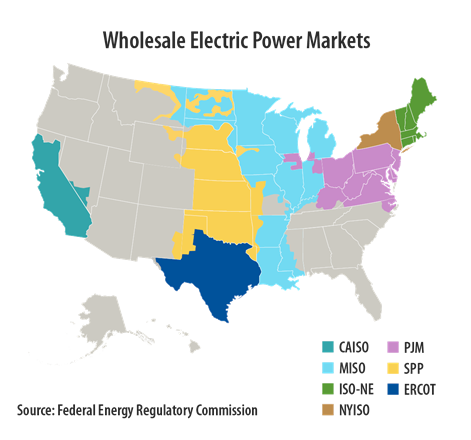
Some parts of the U.S. wholesale electricity market are traditionally regulated (gray areas), meaning that vertically-integrated utilities are responsible for the entire flow of electricity to consumers. They own the generation, transmission and distribution systems used to serve electricity consumers.
Other parts of the wholesale market (Northeast, Midwest, Texas, and California) are restructured competitive markets. These markets are run by independent system operators (ISOs) (we use ISOs to stand for both RTOs and ISOs). ISOs use competitive market mechanisms that allow independent power producers and non-utility generators to trade power. In restructured competitive markets, "utilities" are commonly responsible for retail electricity service to customers and are less likely to own generation and transmission resources.
Retail Electricity Markets
Retail markets are determined at the state-level and can be traditionally regulated or competitive. In a traditionally regulated retail electricity market (gray), consumers cannot choose who generates their power and are required to purchase from the utility in that area. Traditionally regulated electricity markets dominate most of the Southeast, Northwest and much of the west (excluding California). In these states, most renewable energy projects are utility-owned. As a result, developing large green power project in a traditionally regulated state and claiming renewable energy use can often be challenging.
Competitive retail electricity markets (blue) allow electricity consumers to choose between competitive retail suppliers. These electricity markets have opened generation for competition from independent power producers in 24 states (e.g., California, Texas and most states in the Northeast). Eighteen of these states and Washington D.C. have also introduced retail choice, which allows residential and/or industrial consumers to choose their own electricity provider and generation options, including renewable energy. There is greater flexibility around the structure of a retail supply contract, the location of the project, and the scale of selected renewable source.
In these competitive markets, municipally-owned utilities may not offer their customers retail choice. It is important to note that the market is not always divided clearly between traditionally regulated markets and competitive market states. Some states, like California, are partially restructured markets and only permit certain consumers to engage in retail choice.
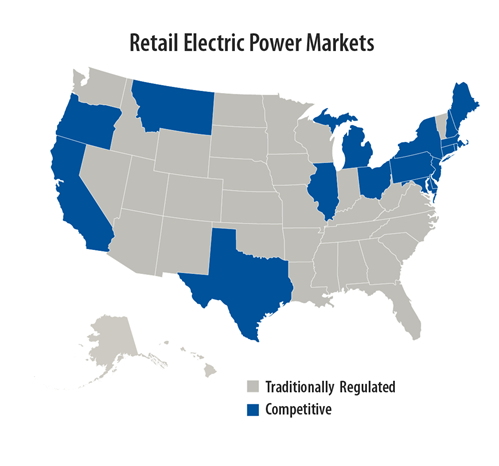
Market Structure Affects the Available Renewable Energy Options
Available renewable energy options can be directly affected or constrained by electricity market structure as well as state and utility policies.
Customers in traditionally regulated markets with vertically-integrated utilities are largely limited to green power products offered by their utility, which are called "utility" products or "green pricing" products. These are "bundled" products that include renewable energy certificates (RECs) with electricity service. Participating customers usually pay more for renewable electricity in their electric utility bill. Another green power product only available in traditionally regulated markets are "green tariffs", which are bundled green power products from specific renewable energy projects procured through special utility tariff rates.
Customers in competitive electricity markets can shop various electricity service providers for "competitive" products or "green marketing" products, which are optional product offerings for customers in competitive or deregulated markets to procure bundled renewable electricity from their default utility supplier, or from an alternative competitive electricity supplier.
Market structure also significantly impacts an electricity consumer's ability to engage in a power purchase agreement (PPA). To engage in a physical (direct) PPA, an electricity consumer must be in a competitive retail market and the project must be in a competitive wholesale market that is interconnected with the consumer's ISO. To engage in a financial PPA, an electricity consumer can be anywhere in the U.S. and the project must be in a competitive wholesale market.
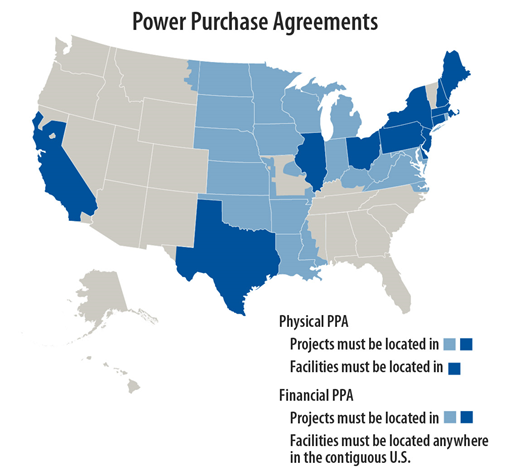
Additional Resources
- U.S. Energy Information Agency. How Electricity is Delivered to Consumers Exit
- U.S. Environmental Protection Agency. U.S. Electricity System and its Impact on the Environment
- U.S. Department of Energy. United States Electricity Industry Primer Exit
- Regulatory Assistance Project. Electricity Regulation in the US: A Guide Exit
